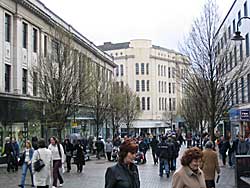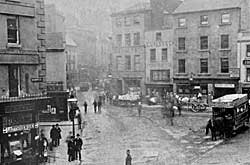< Previous | Contents | Next >
Albert Street and St Peter's Square
ALBERT STREET.

Albert Street (A Nicholson, 2004).
Albert Street is a modern thoroughfare. It was not formed until 1846 and is named in honour of the Prince Consort. In clearing its site it was found necessary to destroy a great deal of old property including a half-timbered house fronting on to St. Peter's Square in which, in 1749, Dr. Deering, the eminent historian, died in absolute poverty, which poverty was largely attributed to his furious temper and warped outlook upon life, probably he was much soured by the fact that he was a foreigner living amongst people who were incapable of appreciating his worth, but however unpleasant he may have been to his contemporaries, modern antiquaries are very much indebted to him for his History of Nottingham.
We have seen how the building once used as the City Treasurer's Office was erected in 1846 as a Post Office from the designs of a certain Mr. Wood. This building was regarded as the ne plus ultra of its day, and one has only to enter it and see how inconveniently planned it is from a modern standpoint to realise what vast strides have been made in office planning during the last eighty years.
ST. PETER'S SQUARE.
St. Peter's Square is a comparatively modern name for the area in front of St. Peter's Church and it was first used as far as I know in 1787. It seems to have been a very unpleasant neighbourhood during the 17th century, for it was so muddy and foundrous that in 1641 we have a reference to a plank causeway for the accommodation of foot passengers from St. Peter's Church to Lister Gate, and as this would have to go round the narrow St. Peter's Church Side and Church Street it must have added very much to the gaiety of the traffic in that neighbourhood. The churchyard remained unfenced until 1641, and in those days it was very much larger than it is nowadays and it is quite likely that it became the receptacle of all manner of debris and unpleasant objects.

St Peter's Square in 1885.
When the Butter Cross was taken down in the Great Market in the year 1700, an attempt was made to bring the butter market into St. Peter's Square and by 1750 a market for the sale of country produce was established here on Mondays. Cattle and sheep were also sold here on Wednesdays and Saturdays so what with one thing and another the already muddy area must have been churned up in a very unpleasant manner. To do away with some of this traffic the sheep and cattle market was moved to Beastmarket Hill as we have seen, in 1808, where the cattle market had been in ancient times.
There was a cross called Monday Cross mentioned here about the year 1700. It appears to have been a roofed structure standing upon four pillars and was used to house the fire engine till 1787, then it was taken down and its place was occupied by a great obelisk which was railed round and which carried four lamps. We are carefully told that this obelisk was intended "as an ornament for the main sewer." In 1819, when gas was introduced for public lighting into Nottingham, this obelisk was illuminated by gas lamps and a very ingenious device was employed for lighting these lamps which were a considerable height above the roadway. A long pipe carrying the gas was run up to the lamps and this pipe was perforated by many small holes. When the gas was turned on, of course it escaped through these holes and the lamplighter applied his flambard to the lowest of these escapes which immediately took fire and passed the flame along from escape to escape until it climbed up to the lamps which it lighted, they being served from a separate pipe and as soon as they were lighted the "climbing light" was turned off. The whole proceeding must have been of very doubtful efficiency on a wet or stormy night.
But the Monday Market was never a great success in spite of this elaborate illumination, and in 1836 the obelisk was pulled down and the Monday Market abandoned.
One of the inns "The Eight Bells" facing into St. Peter's Square has an interesting recruiting history, and in 1778 we find an advertisement for recruits which says "they will be welcome to a good English ordinary of roast beef and plum pudding and a ticket for the play at night, will be paid a handsome bounty and be quartered in the delightful town of Kingston-upon-Hull where excellent ale is sold at 3d. a full quart."
There are many of these old recruiting posters preserved in books about Nottingham, the strangest
of which, I imagine, must have been satirical and read thus, "I will lead you into a country where the rivers consist of fine nut brown ale, where the houses are built of hot roast beef and the wainscots papered with pancakes, there it rains plum pudding every Sunday morning and the streets are paved with quartern loaves."
